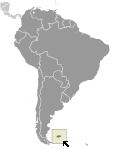World Atlas: Falkland Islands (Islas Malvinas). On this page you can see the map, country flag and many detailed information about the people, history and economy of Falkland Islands (Islas Malvinas).

Here you can find online selected information about the geography, inhabitants, government, economy and history of Falkland Islands (Islas Malvinas). Included are selected statistics, an overview map and the detailed map of Falkland Islands (Islas Malvinas). But let's start with the flag of Falkland Islands (Islas Malvinas) here:
Falkland Islands (Islas Malvinas) - Overview:
What you should know about Falkland Islands (Islas Malvinas)? Let's start with this: Although first sighted by an English navigator in 1592, the first landing (English) did not occur until almost a century later in 1690, and the first settlement (French) was not established until 1764. The colony was turned over to Spain two years later and the islands have since been the subject of a territorial dispute, first between Britain and Spain, then between Britain and Argentina. The UK asserted its claim to the islands by establishing a naval garrison there in 1833. Argentina invaded the islands on 2 April 1982. The British responded with an expeditionary force that landed seven weeks later and after fierce fighting forced an Argentine surrender on 14 June 1982. With hostilities ended and Argentine forces withdrawn, UK administration resumed. In response to renewed calls from Argentina for Britain to relinquish control of the islands, a referendum was held in March 2013, which resulted in 99.8% of the population voting to remain a part of the UK.
Geography of Falkland Islands (Islas Malvinas)
 Where on the globe is Falkland Islands (Islas Malvinas)? The location of this country is Southern South America, islands in the South Atlantic Ocean, about 500 km east of southern Argentina. Total area of Falkland Islands (Islas Malvinas) is 12,173 sq km, of which 12,173 sq km is land. So this is quite a small country. How could we describe the terrain of the country? This way: rocky, hilly, mountainous with some boggy, undulating plains. The lowest point of Falkland Islands (Islas Malvinas) is Atlantic Ocean 0 m, the highest point Mount Usborne 705 m. And the climate is cold marine; strong westerly winds, cloudy, humid; rain occurs on more than half of days in year; average annual rainfall is 60 cm in Stanley; occasional snow all year, except in January and February, but typically does not accumulate.
Where on the globe is Falkland Islands (Islas Malvinas)? The location of this country is Southern South America, islands in the South Atlantic Ocean, about 500 km east of southern Argentina. Total area of Falkland Islands (Islas Malvinas) is 12,173 sq km, of which 12,173 sq km is land. So this is quite a small country. How could we describe the terrain of the country? This way: rocky, hilly, mountainous with some boggy, undulating plains. The lowest point of Falkland Islands (Islas Malvinas) is Atlantic Ocean 0 m, the highest point Mount Usborne 705 m. And the climate is cold marine; strong westerly winds, cloudy, humid; rain occurs on more than half of days in year; average annual rainfall is 60 cm in Stanley; occasional snow all year, except in January and February, but typically does not accumulate.
Inhabitants of Falkland Islands (Islas Malvinas)
Let's take a look how many people live in Falkland Islands (Islas Malvinas). The number is: 3,198. So not so many people live here. Who lives here? Falkland Islander 48.3%, British 23.1%, St. Helenian 7.5%, Chilean 4.6%, mixed 6%, other 8.5%, unspecified 2% (2016 est.). What are the languages in Falkland Islands (Islas Malvinas)? English 89%, Spanish 7.7%, other 3.3% (2006 est.). And the religions: Christian 57.1%, other 1.6%, none 35.4%, unspecified 6% (2016 est.). How old are the people in average? unknown. We have to add that this number is the median - so one half of the people is older than this, one half is younger. And what is their life expectancy (at birth)? This: 77.9. Where the people live in Falkland Islands (Islas Malvinas)? Here: a very small population, with most residents living in and around Stanley. The major urban areas of Falkland Islands (Islas Malvinas) are: Stanley (capital) 2,000 (2014).
Government and Economy of Falkland Islands (Islas Malvinas)
The capital of Falkland Islands (Islas Malvinas) is Stanley and the government type parliamentary democracy (Legislative Assembly); self-governing overseas territory of the UK. Let's take a look at the administrative divisions - none (overseas territory of the UK; also claimed by Argentina). Regarding the economy of Falkland Islands (Islas Malvinas), important industrial products are fish and wool processing; tourism. Important agricultural products are fodder and vegetable crops; venison, sheep, dairy products; fish, squid. The most important export commodities are wool, hides, meat, venison, fish, squid and the most important export partners are Spain 67.8%, UK 10%, Namibia 8.9%, US 7.2% (2016). The most important import commodities are fuel, food and drink, building materials, clothing and the most important import partners are UK 68.8%, Greece 8.8%, Cote dIvoire 6.7%, Spain 5.7%, Netherlands 4.8% (2016). How rich is Falkland Islands (Islas Malvinas) and how rich are people in this country? The most important number here is GDP per capita (PPP): $96,200 (2012 est.). This means the people are rich on average here. Let's add that this means Gross Domestic Product per person, which is recalculated with respect to the relative cost of local goods and services. And one more important number - population below poverty line: NA%.